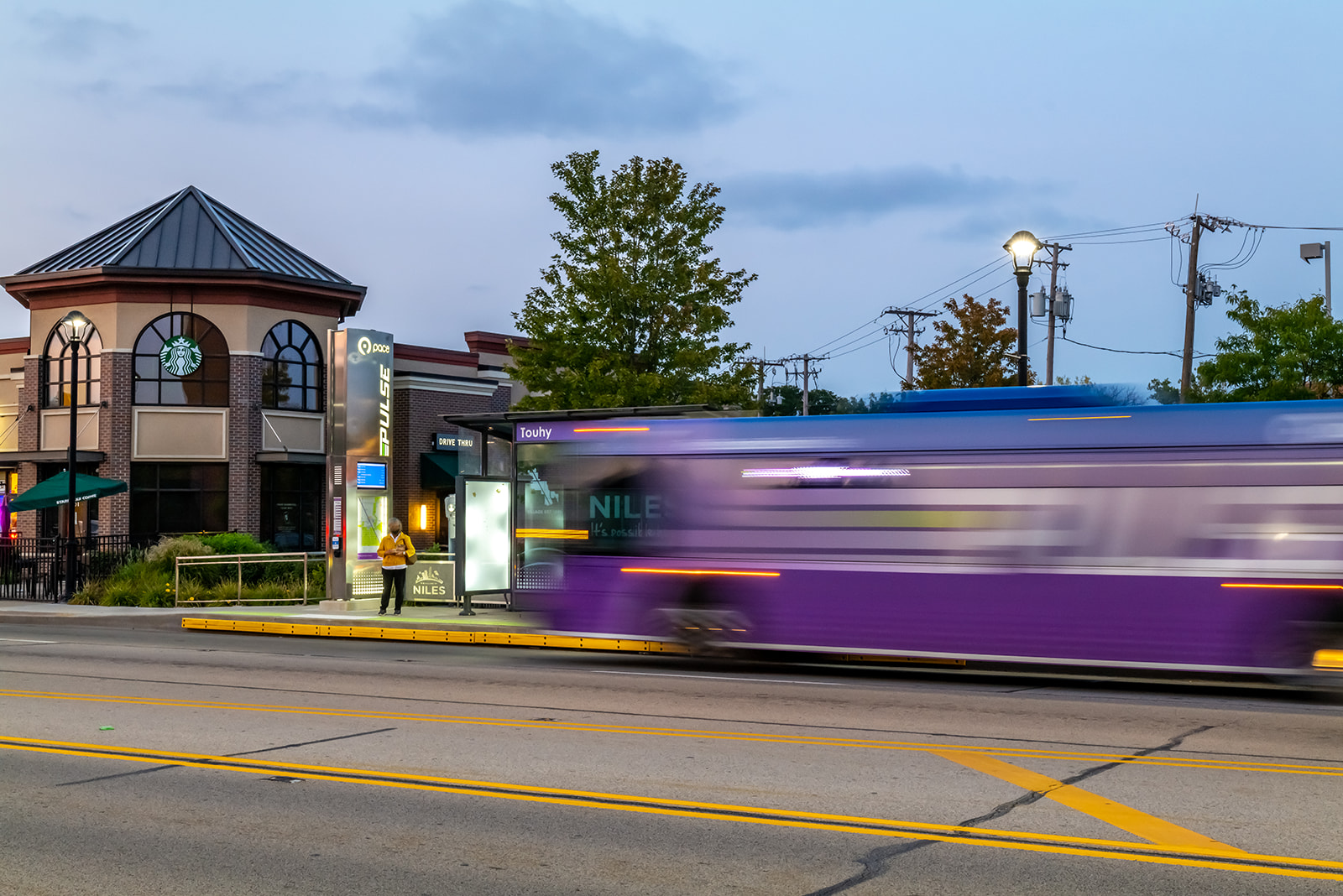
New BRT routes create a premier transit service for Chicago’s suburban bus system
DESIGNER
2024
Pulse is a bus rapid transit (BRT) service offered by Pace, the suburban bus transit provider in northeastern Illinois. Pace’s service area covers more than 3,600 square miles, and the agency delivers safe, comfortable and reliable public transportation throughout 274 municipalities surrounding Chicago. Pace’s newest Pulse BRT lines provide limited-stop bus services with streamlined routes and enhanced amenities along Pace’s most heavily traveled corridors.
“Pace is a critical service provider for residents and workers throughout Chicago’s suburbs, providing nearly 100,000 passenger trips every weekday. Pulse represents a significant increase in the overall level of service and quality of service on some of Pace’s highest-ridership corridors,” said Steven Brown, HNTB program manager, who has been involved with the program since its beginning. “Pulse lines make transit a more efficient and reliable option for customers. The stations also provide a safe and comfortable place to wait for the bus and include improved access for customers at the beginning and end of their trips.”
The Pulse lines were born from a strategic plan that Pace developed to expand mobility options throughout its system and strengthen the transit experience for riders in northeastern Illinois. From the beginning, the goal with Pace’s Pulse lines has been to deliver faster and more reliable public transportation that can help Pace riders more easily access other transit options in the area.
“Our Pulse service reflects Pace’s commitment toward innovation that can make public transportation more attractive in northeastern Illinois. We know that when we build fast and reliable public transportation options, people will choose it,” said Melinda Metzger, Pace executive director. “Pulse provides our riders with fast, frequent and modernized bus service that strengthens connections to the services offered by our sister agencies, CTA and Metra. Pulse is creating a reliable and holistic transit option for our passengers.”
The initial strategic plan identified 24 corridors as potential BRT routes. HNTB was brought on as program manager in 2012 to develop and implement the program, helping prioritize the most promising routes. Pace is currently working to implement 10 priority BRT lines — two of which are up and running with three more in various stages of development.
The first line to be completed was the Pulse Milwaukee Line, launched in 2019. The 7.6-mile Milwaukee Line serves riders between the northwest side of Chicago and the suburban village of Niles. It connects to other Pace and Chicago Transit Authority (CTA) bus routes, the CTA’s Blue Line train to downtown Chicago and O’Hare International Airport, and Metra’s commuter rail service.
The Pulse Dempster Line followed in late 2023, providing faster, more frequent and more reliable service from the northern suburbs of Chicago to O’Hare.
Riders are responding to the BRT service. In the first full month of daily Pulse Dempster Line service in late 2023, combined ridership for the Pulse Dempster Line and the local bus route in the corridor was up 21% compared to the same period in 2022.
As Pace’s program manager for the Pulse program, HNTB works with the agency at every step to implement a new line, leading the early planning and environmental documentation and providing management and oversight through final design and construction.
Planning for a rapid ride
During early planning for the program, HNTB convened a cross-functional working group among Pace’s senior leadership to define the foundational elements of the program, including station design prototypes, service standards, station and vehicle functional requirements and the Pulse brand.
“It was important to build ownership and buy-in across the agency, from the operations team to marketing, community relations and capital infrastructure,” Brown said.
Those early design workshops set the standards for the system, including service frequency, the typical distance between stations, along with their size, aesthetics and amenities. In those workshops, Pace officials stressed the importance of passenger comfort and service reliability, emphasizing items like real-time passenger information, easy-to-find stations with a clearly identifiable brand and protection from the elements during northeastern Illinois’ harsh winters. To keep passengers warm and dry throughout the year, all Pulse stations feature heated shelters and a pavement snow-melt system to keep the platform clear of snow and ice.
Incorporating “community expression” into the Pulse station designs also became a driver of engagement between Pace and the many communities it serves.
“Some of the lines run through as many as eight municipalities, each with their own priorities, zoning and building codes,” Brown said. “The whole program had to be flexible enough to accommodate each municipality while maintaining a consistent experience throughout for Pulse riders.”
One strategy for building community support was to give each municipality an opportunity to design the back walls of the shelters at Pulse stations within their communities. Images range from town logos to original artwork created by local talent.
Also, while the design of other furnishings, such as bike racks, benches and railings, were standardized, the Pulse team recognized early on that some communities had already completed extensive streetscape and beautification plans. Pace established policies to work with those communities to incorporate their existing streetscape elements into stations, where possible. The agency uses this same approach when working with property owners to site Pulse stations on or adjacent to their property. Pace made the decision to cover the cost of these community expression elements to ensure they would be included without regard to an individual community’s financial resources.
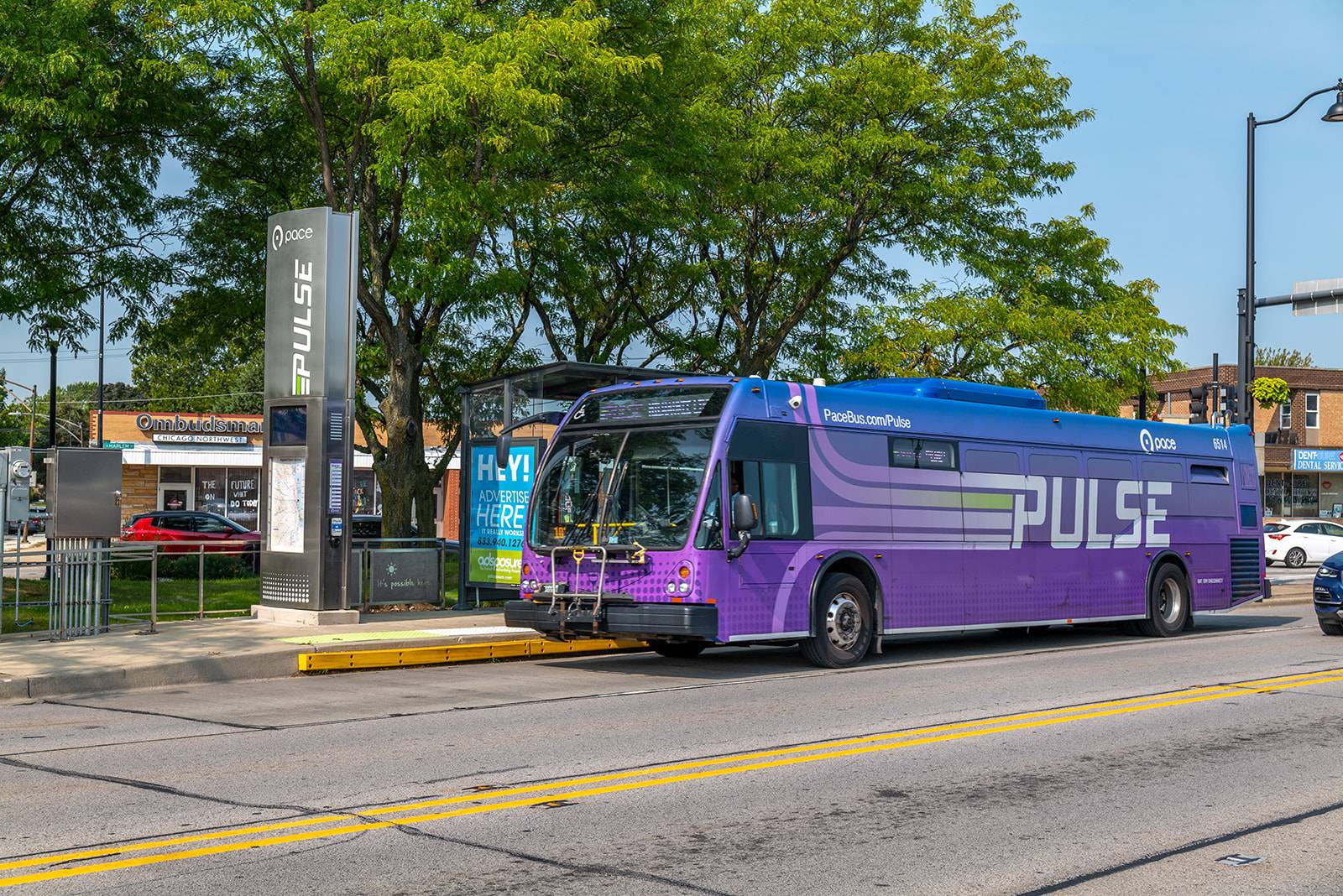
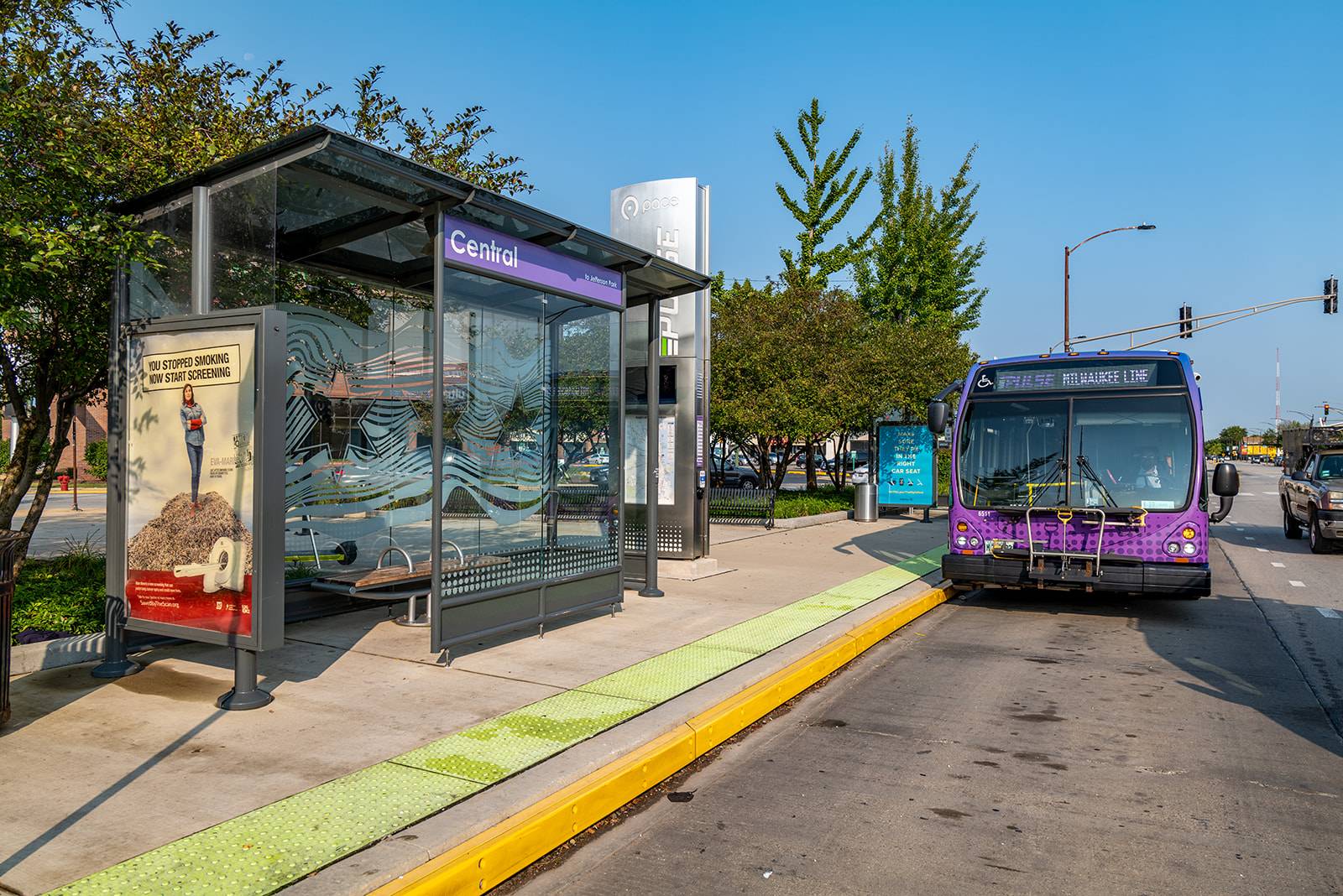
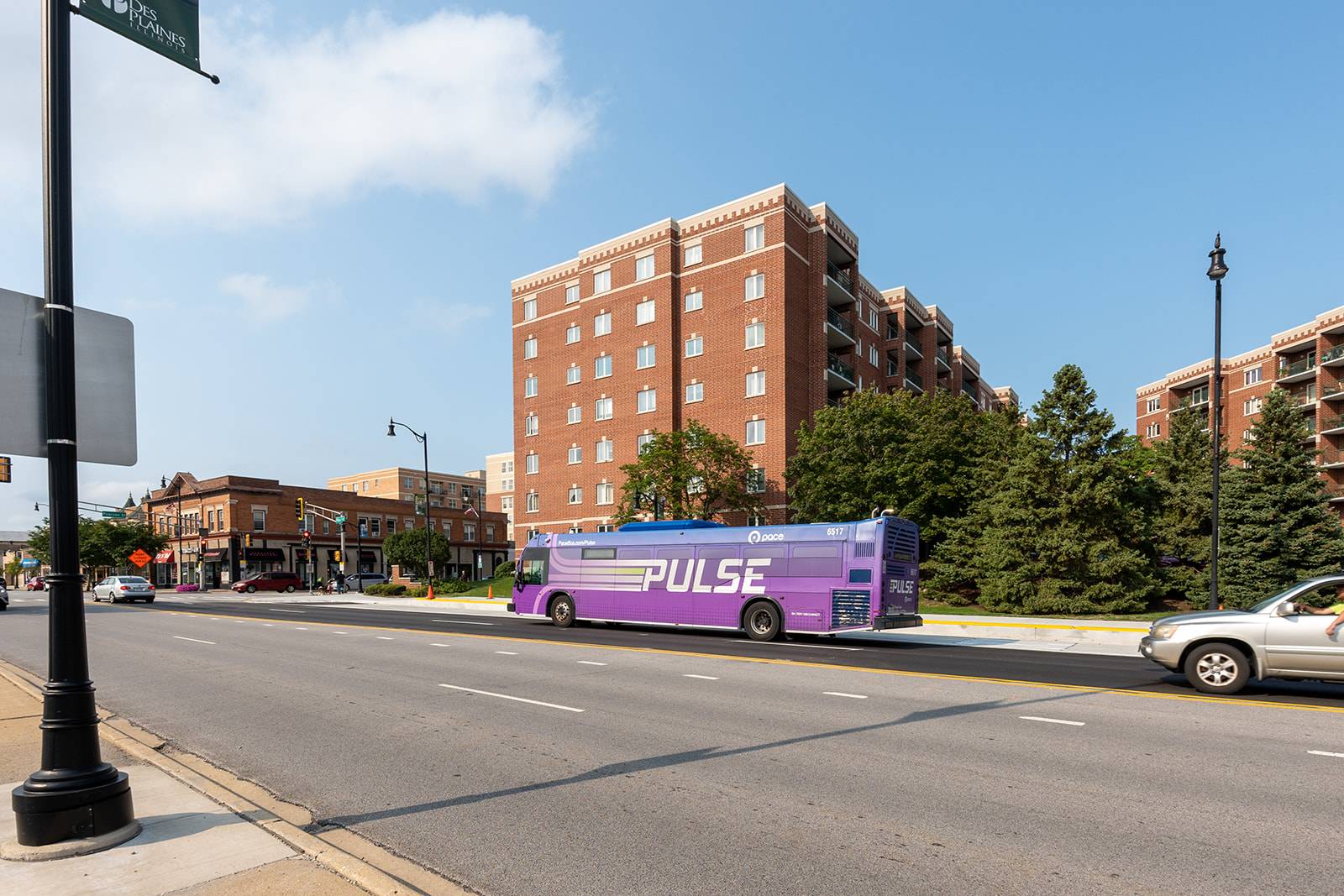
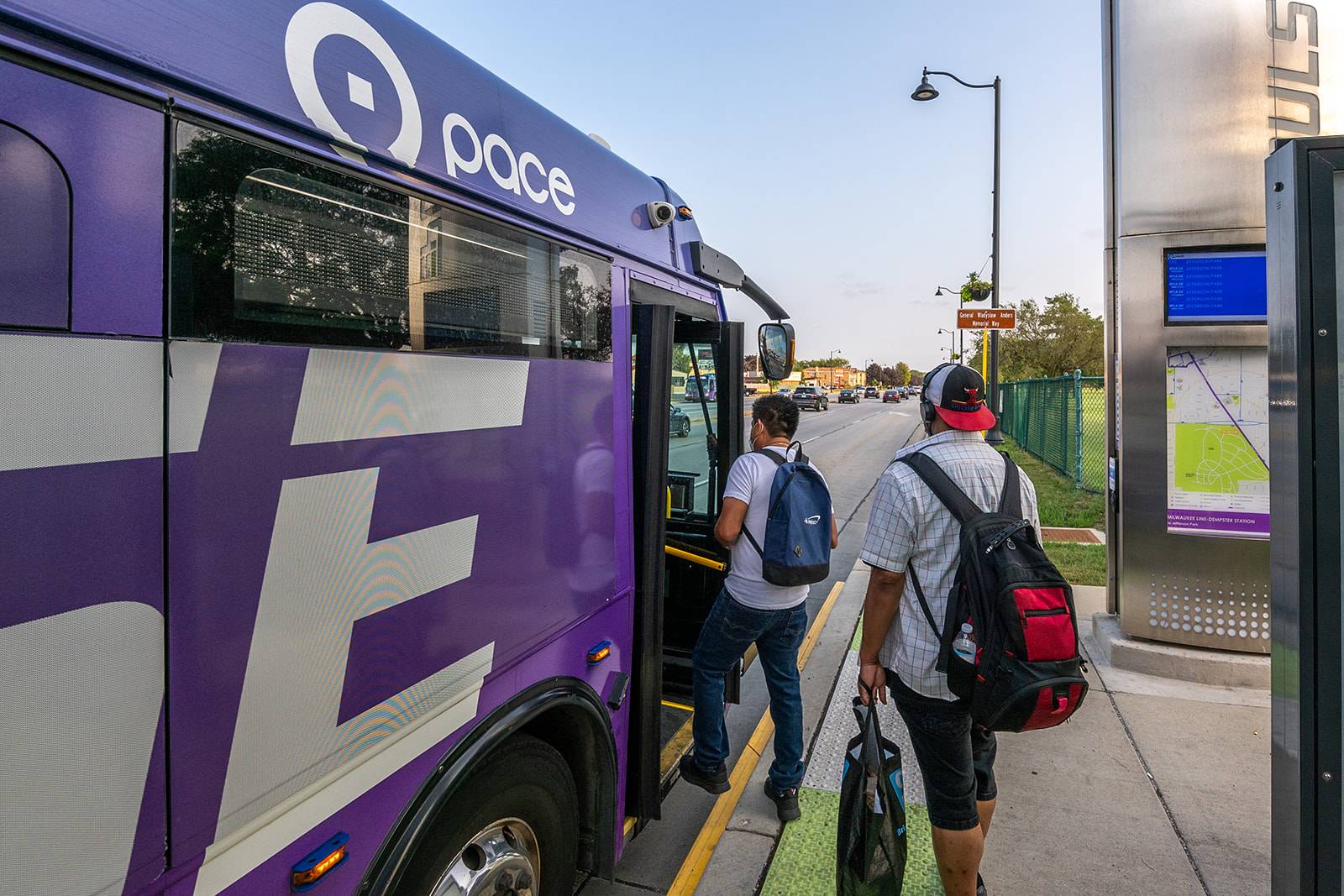
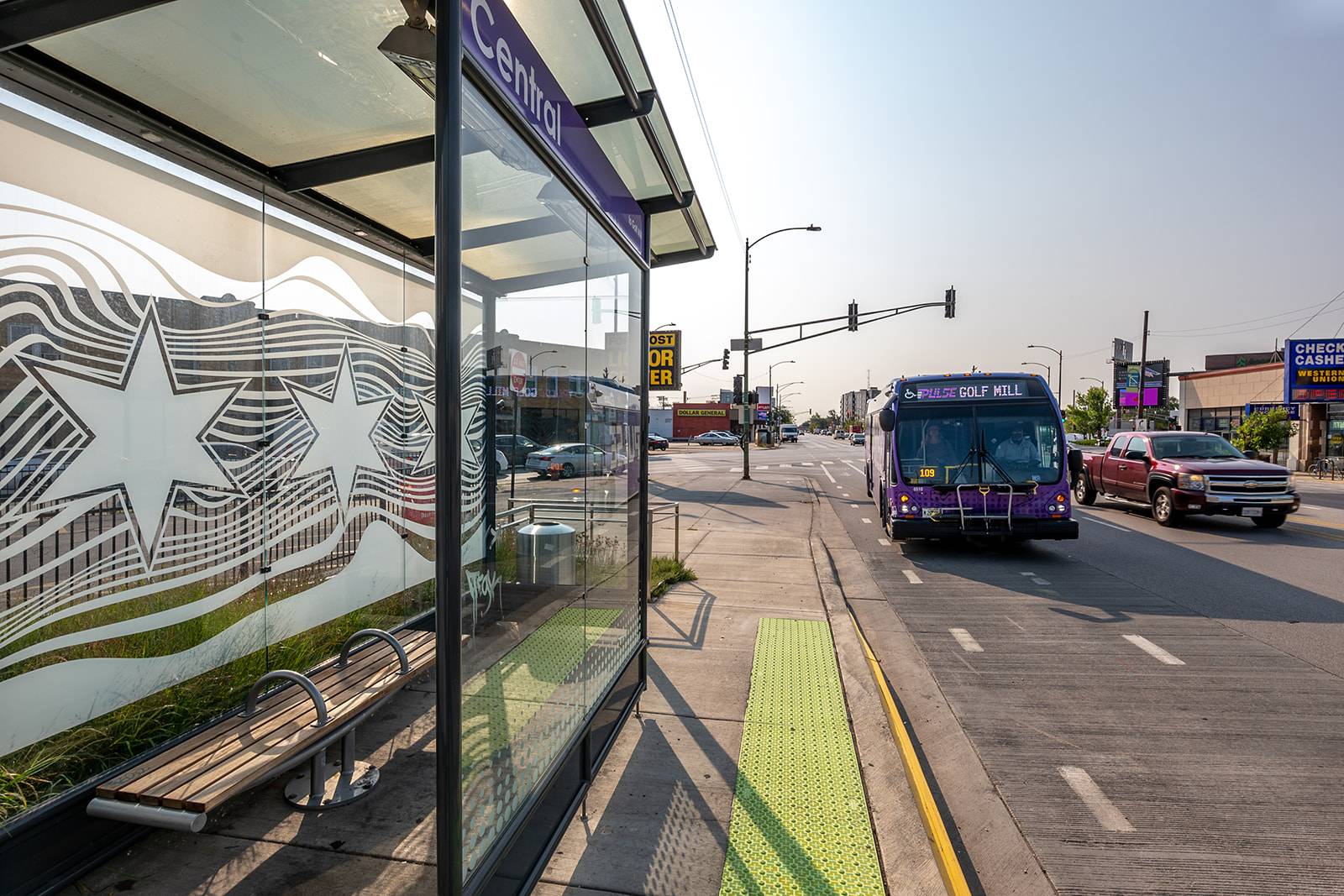
The Pulse network is planned to eventually include 10 corridors and nearly 115 miles of new infrastructure and service improvements.
Pulse Milwaukee Line
Opened in 2019
7.6 miles long
10 stations
Pulse Dempster Line
Opened in 2023
15.4 miles long
17 stations
Pulse Halsted Line
Status: in final design
8.5 miles
16 stations
Pulse 95th Street Line
Status: In final design
13 miles long
20 proposed stations
More than a building
Because Pulse lines run through numerous municipalities and often operate on state-controlled roadways, approvals for design and construction typically go through numerous overlapping jurisdictions and requirements. The planning team had to accommodate all these various design standards, ordinances and policies. Within the City of Chicago, the Illinois Department of Transportation (IDOT) and Chicago Department of Transportation (CDOT) often share jurisdiction over the same roadways, furthering the need for extensive design coordination.
IDOT’s design manuals did not account for all the planned station design features, such as raised level-boarding platforms and plastic curb bumpers that allow buses to dock at stations. Pace identified that these features were essential for delivering a more comfortable and convenient boarding experience. Pace worked with HNTB and IDOT to research best practices and seek and obtain approval for these features.
The 12-inch-high level boarding platform is of particular importance as it allows passengers to step directly onto the bus without requiring the bus to kneel to accommodate passengers with limited mobility. Not only is this more convenient for customers, it also speeds up service. HNTB developed a safety study examining where other BRT systems around the U.S. used these raised curbs along major arterials. The team also worked closely with IDOT to pilot their use on the Pulse Milwaukee Line before gaining approval to propose them throughout the Pulse network.
Unlocking federal grants for infrastructure
Federal grants are often essential in helping agencies deliver improved mobility for the communities they serve. The Pulse projects were no exception. Pace’s first four Pulse BRT lines have all received significant federal support, with up to 80% of construction costs coming from competitive federal discretionary grants. HNTB helped Pace identify those grants and deliver a compelling story for the projects and their value to communities they serve, leading to a successful grant. HNTB has supported Pace with at least six successful federal grant applications totaling nearly $75 million in grant awards, including a $20 million RAISE grant in 2023 that will fund construction of the Pulse Halsted Line.
“It’s just more pleasant as a passenger to make walking right onto the bus more like stepping onto a subway train,” Brown said.
Sidewalks — or the lack of them — also are a frequent challenge for Pace customers. Particularly in the suburbs, sidewalk gaps are widespread, even on major roadways and, as Brown pointed out, “Pace is not a roadway agency. They operate buses. So, it was new for them to look at building new infrastructure in the public right-of-way.”
HNTB helped Pace establish policies around sidewalk construction, wheelchair ramps and the area around stations that gives passengers full and safe access as they board and leave the buses and the stations.
Many American cities are in the process of considering, developing or expanding BRT, and they likely will face challenges that go far beyond simply connecting point A to point B, especially in suburban contexts.
“You’re probably going to be passing through some areas where it is challenging to be a pedestrian,” Brown said. “To really be successful, it's much more than just providing service and moving buses faster. Bus passengers usually start and end their trip as a pedestrian, so we have to consider the whole trip.”
Collaboration is key
When a transit agency seeks to build infrastructure along a public roadway, early collaboration with the roadway agencies is critical. Pace already had long-standing relationships with CDOT and IDOT, but implementing BRT features required those relationships to expand to different departments and individuals who had not worked together as much in the past. HNTB’s extensive and multifaceted relationships with CDOT and IDOT were helpful in identifying and connecting Pace with key decision-makers to coordinate on early design concepts and ultimately facilitate approvals and permitting.
“It really demonstrates the interdisciplinary nature of these projects. Even within our own team at HNTB we had to work across departments and practice areas. We depended heavily on our roadway design group to not only help us with design, but to know what the roadway agencies would allow, what would be issues for them and to connect us and Pace with the right people within those agencies to form a productive collaboration from the get-go,” Brown said.
Building on success
Building on the success of the first two Pulse lines, Pace has even greater ambitions for its next lines. Pace and HNTB are working together to expand the Pulse infrastructure program on future corridors to include bus-only lanes and queue jumps, which allow buses to bypass traffic at congested intersections. The program team is also proactively engaging IDOT, CDOT and other agencies as they comprehensively reimagine some of the arterial corridors where Pulse service now or will someday operate. Transit is just one piece of a broader Complete Streets strategy that all adds up to better pedestrian safety, sustainable mobility and economic development.
“We are examining opportunities to team up with our roadway agency partners to redesign the roadway and major intersections to be more pedestrian-friendly and prioritize modes other than single-occupant cars,” Brown said. “It’s part of a strategy to make transit not only more efficient but safer and more comfortable for customers to access the bus and enjoy their trip.”
“Collaboration has been an integral part of our Pulse program,” Pace Chairman Rick Kwasneski said. “Pace will continue to collaborate with our communities, with our sister agencies and, most importantly, with those we serve. We are grateful for our partners, and I look forward to seeing what we achieve together in the coming years.”
SEE MORE ARTICLES
MORE DESIGNER STORIES
Orlando International Airport Terminal C
Fish Passage
Denver International Airport A-West and B-West Concourses
CID Green Infrastructure Project
KC Levees Program
